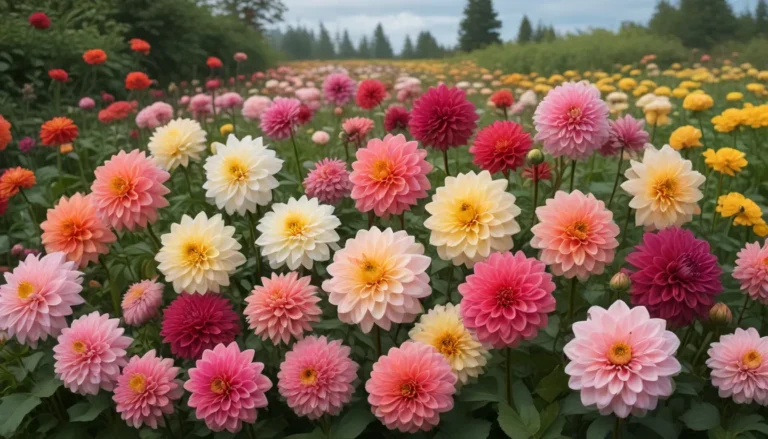The Complete Guide to Growing and Caring for Coffee Plants Indoors

Are you a coffee enthusiast or just looking to add some greenery to your home? Coffee plants are an excellent choice for both scenarios. They have beautiful glossy leaves and are forgiving of those with less than perfect gardening skills. However, they do require some care and attention to thrive, especially when grown indoors.
In this comprehensive guide, we will cover everything you need to know to successfully grow and care for coffee plants in your home. So grab your favorite cup of joe and let’s dive in!
What Is a Coffee Plant?
Coffee plants belong to the Coffea genus and are the same plants that produce the coffee beans we all know and love. While they can grow up to six feet tall in ideal conditions, most indoor specimens remain smaller. These plants are toxic to humans and pets, so it’s best to refrain from nibbling on the leaves.
The most common species you’ll come across is Coffea arabica, known for its prized coffee beans. While it’s rare for indoor plants to produce flowers and berries, it’s not impossible with the right care.
Cultivation and History
Coffee cultivation has a rich history dating back centuries, with origins in Ethiopia before spreading to the Arabian Peninsula and beyond. By the 1500s, coffee had made its way to Europe and the Americas, eventually becoming a beloved beverage worldwide.
As a houseplant, coffee plants have become increasingly popular in recent years. Their easy-going nature and lush foliage make them a favorite among plant enthusiasts.
Propagation
You can propagate coffee plants from seeds or cuttings, with spring being the best time for both methods. Fresh coffee seeds are rare in nurseries, but they can be found online. When growing from seeds, ensure proper soil moisture and light conditions for germination. Cuttings from mature plants can also be used for propagation, with attention to maintaining high humidity levels.
Transplanting seedlings is another option if you prefer not to propagate from seeds or cuttings. Simply select healthy seedlings from a nursery and transfer them to a new container with fresh potting soil.
How to Grow
Watering is key to keeping your coffee plant healthy. Maintain soil moisture levels and provide adequate humidity to prevent leaf damage. Using a well-draining potting mix and positioning the plant in bright, indirect light will promote healthy growth. Regular feeding with a balanced liquid fertilizer is also essential for optimal plant health.
Growing Tips
- Provide bright, indirect light.
- Keep the soil moist.
- Maintain high humidity levels for healthy plants.
Pruning and Maintenance
Regular pruning helps prevent legginess and encourages bushy growth. Dusting the leaves periodically and maintaining optimal growing conditions are essential for plant longevity. Encouraging flowering and fruit production requires specific care, including enhancing soil acidity and providing outdoor exposure during the summer.
Cultivars to Select
The most common coffee cultivar is Coffea arabica, known for its quality beans. While specific cultivars with unique characteristics are less common for houseplant varieties, options like Bourbon, Gesha, and Typica are well-suited for indoor growing due to their compact growth habits and attractive foliage.
Managing Pests and Disease
Coffee plants are generally resilient to pests and diseases when kept healthy. The most common issues include root rot and insect infestations such as aphids, mealybugs, and spider mites. Regular inspection and treatment with neem oil or other remedies can help prevent and control these problems.
Best Uses
Coffee plants make beautiful standalone specimens, but pairing them with companion plants can enhance their visual appeal. Experimenting with flowering and fruiting can be a rewarding challenge for plant enthusiasts looking to expand their gardening skills.
Quick Reference Growing Guide
- Plant Type: Woody shrub
- Native to: Arabian Peninsula, Ethiopia
- Hardiness (USDA Zone): 10-11
- Exposure: Bright, indirect light
- Height: Up to 15 feet
- Spread: Up to 10 feet
- Water Needs: Moderate
- Common Pests and Disease: Aphids, mealybugs, spider mites; crown rot, root rot
Conclusion
Growing and caring for coffee plants indoors can be a rewarding experience for plant lovers and coffee enthusiasts alike. With proper attention to watering, light, and humidity levels, you can enjoy the beauty of lush foliage and even the chance of flowers and fruits in your own home. Experimenting with different cultivars and propagation methods can add variety to your indoor garden. So go ahead, brew yourself a fresh cup of coffee and enjoy the lush greenery of your coffee plant companion!





